Discover the Flavors of Sri Lanka: You shouldn’t miss this list of Sri Lanka food
Sri Lanka is a food lover’s paradise, with a rich culinary heritage that reflects its cultural diversity. From traditional breakfast dishes to street food favorites, Sri Lanka has a wide range of mouth-watering options to tantalize your taste buds. In this guide, we’ll take you on a culinary journey through the country’s most popular and authentic dishes. Of course, the list is biased to the favorites we like, as Sri Lankans but that makes this list very authentic and genuine too.
But fair warning, when you talk about Sri Lanka food, no list is ever complete. There’s so much of foods Sri Lanka offers and it’s going to be an encyclopedia if each and every Sri Lanka food, dish, menu, ingredient is listed.
Sri Lankan food is a vibrant mix of spices, herbs, vegetables, rice, and coconut-based dishes. It reflects the island’s rich cultural history, influenced by Indian, Arab, Malay, and European cuisines. The food here is known for its distinct flavor profiles, ranging from fiery curries to refreshing coconut-based dishes as well.
Fun fact about Sri Lanka food is, Coconut is one of the main elements. Whether it’s coconut oil, grated coconuts, dried grated coconuts, coconut as a whole plays a major role in many of Sri Lanka foods.
The Must-Try list of Sri Lanka Food
This list for the must-try Sri Lanka food is just the start. Not the entire list or even complete because there’s so much to choose from and every dish, meal has it’s unique taste and texture. But, let’s try to list out the most famous so there’s a start.
Kottu Roti (Koththu/Kottu) – කොත්තු

One of the personal favourites and also a very widely available dish in Sri Lanka is Kottu Roti, as the locals call it – Koththu. Kottu is a beloved Sri Lankan street food made from chopped roti (a very thin crusted pizza-type that’s cut into tiny pieces), vegetables, eggs, and your choice of meat or seafood. It’s a dish that embodies the island’s love for spice and flavor. You’ll often find vendors rhythmically chopping Kottu on hot plates, a sound that is as iconic as the dish itself.
Kottu often complimented with adding Cheese and Roasted-Chicken. And we call is Cheese Kottu. Personal favourite is Beef Kottu with cooked beef added to the Kottu and that’s super delicious. Kottu is widely available in almost all food outlets, especially served as a Dinner time Sri Lanka food.
Kottu is mainly a dinner time Sri Lanka meal. Well, now that it’s popular with every culture, every tourist, many places offer Kottu for lunch as well.
You can try Kottu either at the restaurants, street-food vendors, or even at many of the hotel buffets too. I think Kottu is one of the most adored Sri Lanka foods ever!
String Hoppers (Indiappa) – ඉඳි ආප්ප
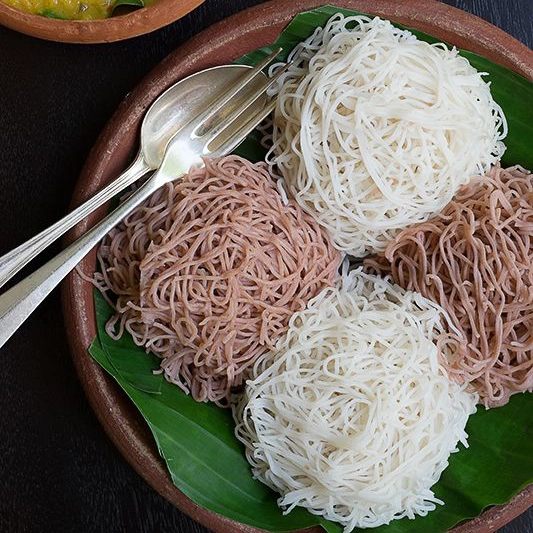
String Hoppers are a very popular and often seen Sri Lanka food in many homes. Made from rice flour, these delicate noodle-like discs are usually served with coconut sambol, dhal curry, or a meat curry. This dish is light yet filling, making it a perfect breakfast or dinner option.
The white string hoppers are made from rice flour while the red string hoppers are made from Kurakkan flour (finger millet flour). That gives the red-ness of the string hoppers and considered more healthier and less-prone to carbohydrates and diabetes than the rice flour. But that’s not scientifically proven yet a famous saying among the many string hopper fans.
String Hoppers are sometimes sold as packets of 10-20 pieces with a small quantity of Pol Sambol. We will talk about Pol Sambol later in this guide as it’s a very popular Sri Lanka condiment for many food items.
Like mentioned, it’s famous as a breakfast and dinner meal as it’s light, easy to find in many food outlets in Sri Lanka.
Pol Roti (Coconut-induced white flatbread) – පොල් රොටි
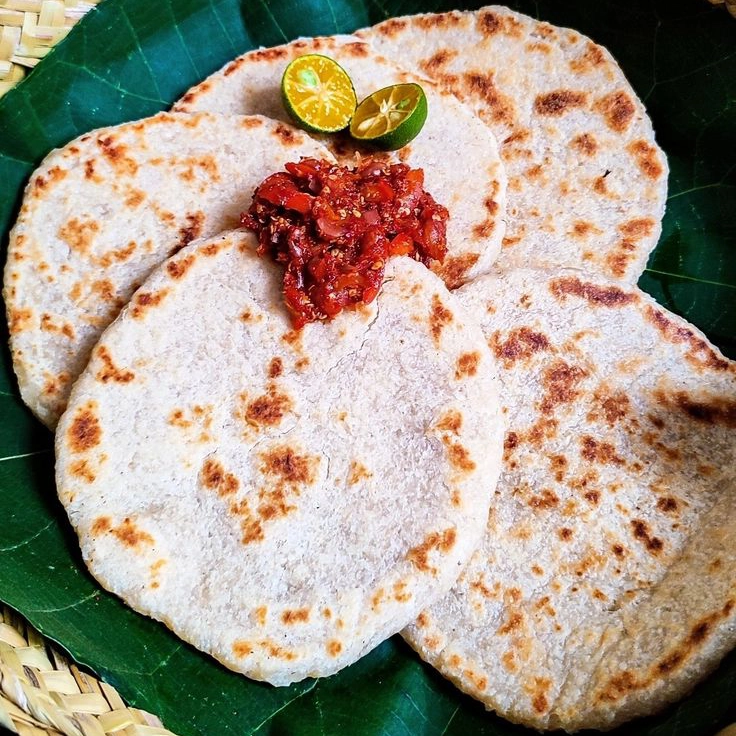
Pol Roti is a type of flatbread made with freshly grated coconut. It’s soft, slightly sweet, and pairs perfectly with spicy sambols or curry. It’s a must-try for those looking to experience the simplicity and deliciousness of Sri Lankan food.
Flour, mixed with grated coconut and water is flatted like a pan-pizza and then burned/roasted until it becomes crusted on a metal plate. One of the most popular breakfasts and sometimes available for dinners is Pol Roti and quite famous in the rural areas as their go-to food and snack.
The red item is called Lunu Miris and that’s onions mixed with red chillies and with some lime drops for the flavour. This is very spicy and hot and even the Pol Roti is enjoyed while it’s a bit heated too. That really makes one of the best combinations to eat.
Fun fact: The 2024 Presidential Candidate for Sri Lanka; Dilith Jayaweera is famous for eating Pol Roti as a meal.
Rice and Curry (බත් සමග ව්යංජන)

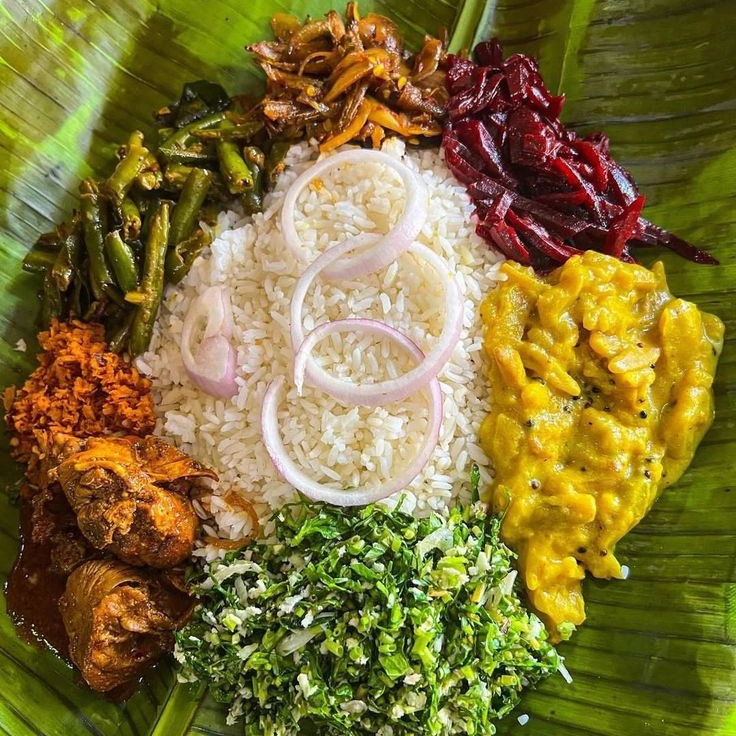
Rice and Curry is Sri Lanka’s #1 Food. This is like the only Sri Lanka food which anyone can eat for all 3 meals and actually do too. As colorful as it could be, a variety of tastes and flavours you can think of, whether spicy, sweet, sour, tangy, the Sri Lankan Rice and Curry is full of nutrients and an actually good quantity of food too.
Hoppers and Egg Hoppers (ආප්ප & බිත්තර ආප්ප)

Hoppers are a type of pancake made from fermented rice flour and coconut milk. The bowl-shaped hopper is crispy on the edges and soft in the center. Egg Hoppers have an egg cooked in the middle, making them a popular breakfast and dinner choice.
Many of the Sri Lankans eat Hoppers because it’s a light meal. It definitely needs a lot of practice to perfect the art of making Hoppers and Egg Hoppers as it needs the right mixture, the texture, the bowl and also the right temperature as well.
When you add the Egg to the middle while the Hopper is being cooked/baked, it naturally becomes the “Egg Hoppers”. Now there’s some fusions of adding Cheese, Shredded Chicken meat, even Chocolate to make the Hoppers more delicious and trendy too.
Many Sri Lankan hotels have Hoppers for Breakfast and Dinner but if you check at road-side restaurants, Hoppers are mainly a Dinner-time meal.
Kiri Bath + Lunu Miris (Milk Rice + Onion/Chillie paste) (කිරි බත් + ලුණු මිරිස්)
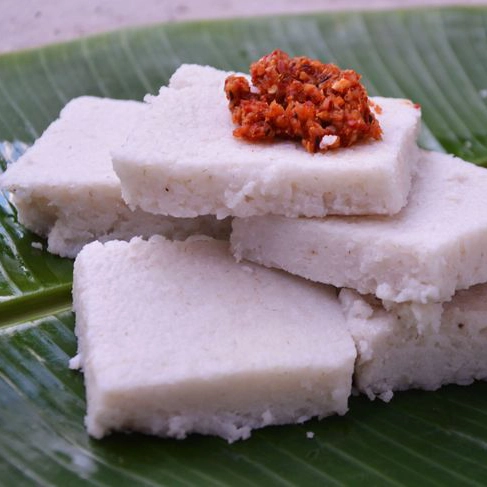
Kiri Bath (Milk Rice) is one of the most ancient and revered dishes in Sri Lanka, deeply embedded in the island’s culture and history. This dish is traditionally prepared using rice and coconut milk and is commonly associated with auspicious occasions, festivals, and religious ceremonies.
Even during the Sinhala and Tamil New Year, Kiri Bath is one of the main dishes of the food table.
Kiri Bath has been a part of Sri Lankan cuisine for centuries, with its origins tracing back to the ancient Sinhalese civilization. The dish is symbolic of purity, prosperity, and new beginnings, which is why it is often the first meal prepared in Sri Lankan households at the start of a new year or on special occasions.
Kiri Bath is mainly a breakfast dish. The Lunu Miris, made from onions and chillies mixed together is the most famous condiment but there are many curries like Chicken Curry, Fish Ambulthiyal, Seeni Sambol that are accompanied when eating Kiri Bath.
The Chinese Buddhist monk Fa Hien, who traveled to Sri Lanka in the 5th century AD, made references to a dish resembling milk rice in his travelogue “A Record of Buddhistic Kingdoms.” While he does not explicitly use the term “Kiri Bath,” his description aligns with the preparation of milk rice. According to Fa Hien:
“On festive days, they cook a dish of rice mixed with cocoanut milk, which they consider sacred.”
This indicates that the practice of preparing a special rice dish with coconut milk, akin to Kiri Bath, was already established by the 5th century.
Robert Knox (1681) in his book “An Historical Relation of the Island Ceylon,” wrote: “The usual diet of the people is rice, boiled with cocoanut milk, which they eat every day at their meals.”. This statement points to the regular consumption of milk rice as a staple in Sri Lankan diet during the 17th century.
Kola Kanda (herbal porridge) – (කොළ කැඳ)
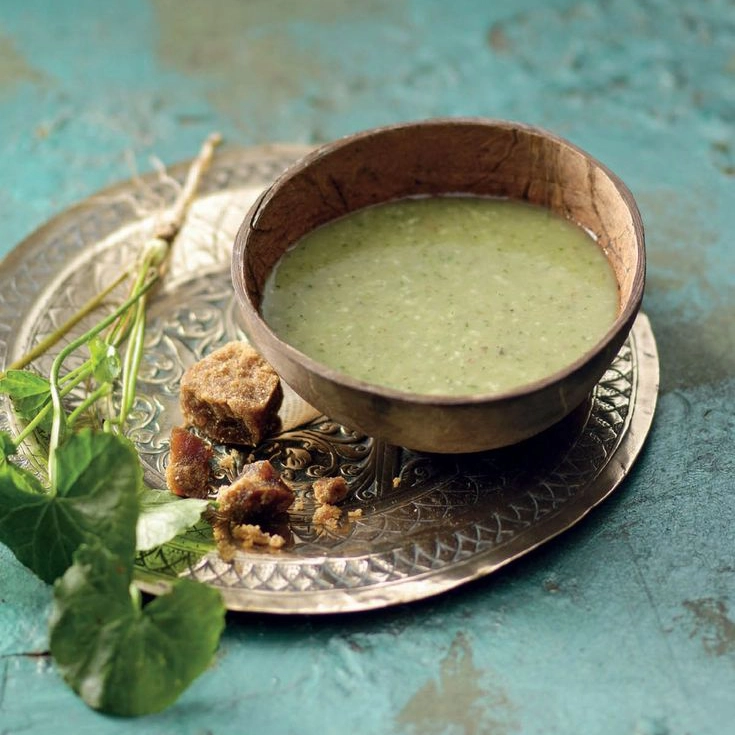
Kola Kanda is a traditional Sri Lankan herbal porridge made from rice, coconut milk, and various green leafy vegetables (known as “kola”). It is not only a popular breakfast dish but also considered a nutritious and healing meal with roots in ancient Ayurvedic practices.
The origins of Kola Kanda can be traced back to ancient Sri Lankan Ayurvedic traditions. It was developed as a medicinal food, believed to promote health and well-being. The dish’s name comes from the Sinhalese words “Kola,” meaning “leaf,” and “Kanda,” meaning “porridge” or “gruel.” Kola Kanda is a reflection of the Sri Lankan people’s deep connection with their natural environment, utilizing local herbs and plants for both nutrition and medicine.
Kola Kanda is mainly a breakfast food but there are varies depending on what types of leaves are used as the main ingredient.
Since it’s a bit sour and very leafy-in taste, a piece of Jaggery is often eaten at the same time. To add weight and make the meal complete, rice is also added to the Kola Kanda to make it fuller.
Here are some famous types of Kola Kanda with their main benefit based on Ayurveda.
- Gotu Kola Kanda – Enhances memory, promotes skin health.
- Polpala Kanda – Detoxifies body, supports kidney function.
- Mukunuwenna Kanda – Rich in iron, boosts nutrition.
- Neeramulliya Kanda – Cools body, aids kidney health.
- Iramusu Kanda – Purifies blood, improves digestion.
Pittu & Babath (steamed cylinder type food + tripe) (පිට්ටු + බාබත්)


Pittu with Babath is a traditional Sri Lankan dish that combines the unique texture of Pittu, a steamed cylinder of ground rice and coconut, with the rich flavors of Babath, which is tripe or offal curry. This dish is deeply rooted in Sri Lankan culinary traditions, particularly in communities where nose-to-tail eating is embraced.
Pittu is made from a mixture of roasted rice flour and freshly grated coconut, layered in a bamboo or metal cylinder, and then steamed. The result is a crumbly yet slightly moist dish that can be easily broken apart. Pittu is often served with a variety of curries, including meat, fish, or vegetable curries. It is a versatile dish that complements the spicy and flavorful curries typical of Sri Lankan cuisine.
Babath refers to the tripe or stomach lining of cattle, goats, or sheep. In Sri Lankan cuisine, Babath is prepared as a rich and spicy curry, often with a complex blend of spices including turmeric, chili, coriander, cumin, and curry leaves. The tripe is slow-cooked until tender, allowing it to absorb the flavors of the spices and coconut milk. The curry is thick, aromatic, and has a slightly chewy texture due to the tripe.
Pittu with Babath is particularly popular in Sri Lanka’s Tamil and Muslim communities but not only to them. Being a Sinhalese, even we cook Babath with Pittu at home for Dinners mostly and enjoy this delicious dish.
Must-try Sri Lanka food: Honourable mentions
Watalappam
Watalappam is a rich and creamy dessert made from coconut milk, jaggery, cashews, and spices. This pudding-like treat is a must-try for anyone with a sweet tooth. When it comes to Sri Lanka food, Watalappam is one fine tasty dessert and mostly popular among the Muslim communities of Sri Lanka.
Lamprais
A Dutch Burgher-inspired dish, Lamprais is a combination of rice, meat, and sambol, wrapped in a banana leaf and baked. The fusion of flavors in this dish is something every food adventurer should experience. This is a main meal, a favourite Lunch meal for many who want to try Sri Lanka food.
Fish Ambul Thiyal
A sour fish curry made with goraka (a dried fruit), Fish Ambul Thiyal is a tangy and spicy dish that’s unique to Sri Lanka. The slow-cooking process makes the fish incredibly tender and flavorful. A must-try Sri Lanka food for anyone liking Fish or want to try Sri Lanka food popular among Sinhalese.
Kalu Dodol
Kalu Dodol is a sticky, sweet treat made from rice flour, jaggery, and coconut milk. It’s rich in flavor and a favorite during festivals and celebrations. Another Sri Lanka food which is considered as a dessert or sweet snack.
Where to Find the Best Sri Lanka Food?
All around the country. Sri Lanka is a foodie’s paradise and the Sri Lanka food is like so common in all the cities and towns. Almost all hotels offer many of the food options listed on this post and you can check at restaurants that serve Sri Lanka food for the dishes as well.
Some famous cities among the travellers who want to try Sri Lanka food and has ample restaurants and food-outlets are Colombo, Kandy, Galle as they are the mainly visited mega-cities but all other towns and places also serve these amazing Sri Lanka food to any food lover.
It’s always a journey in Sri Lanka. If you want to try the best Sri Lanka foods, you should not miss these dishes and meals. The good news is, you can always find these Sri Lanka Food places all across the island and there’s plenty. And many YouTube videos show how to make these Sri Lanka Food at home as well. So there’s a good chance in making them at home as well.
Planning your next Sri Lanka Holiday and want a Sri Lanka Specialist to plan your Trip – including some amazing Sri Lanka Food options?
Contact Meshaun Journeys today!
